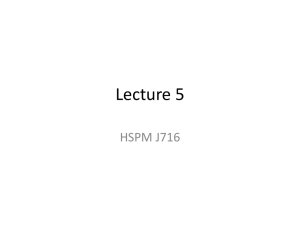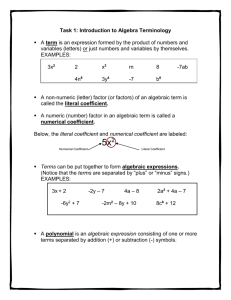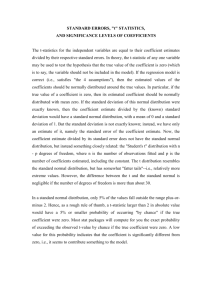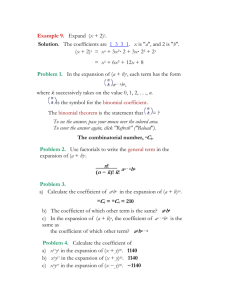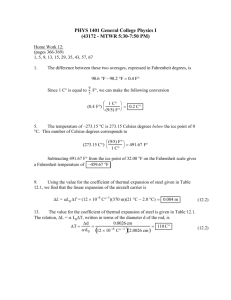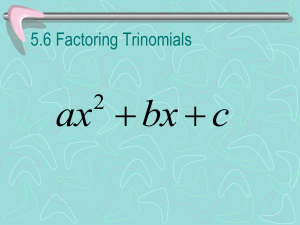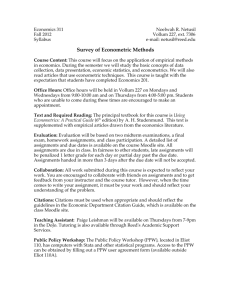Meeting Seven
advertisement
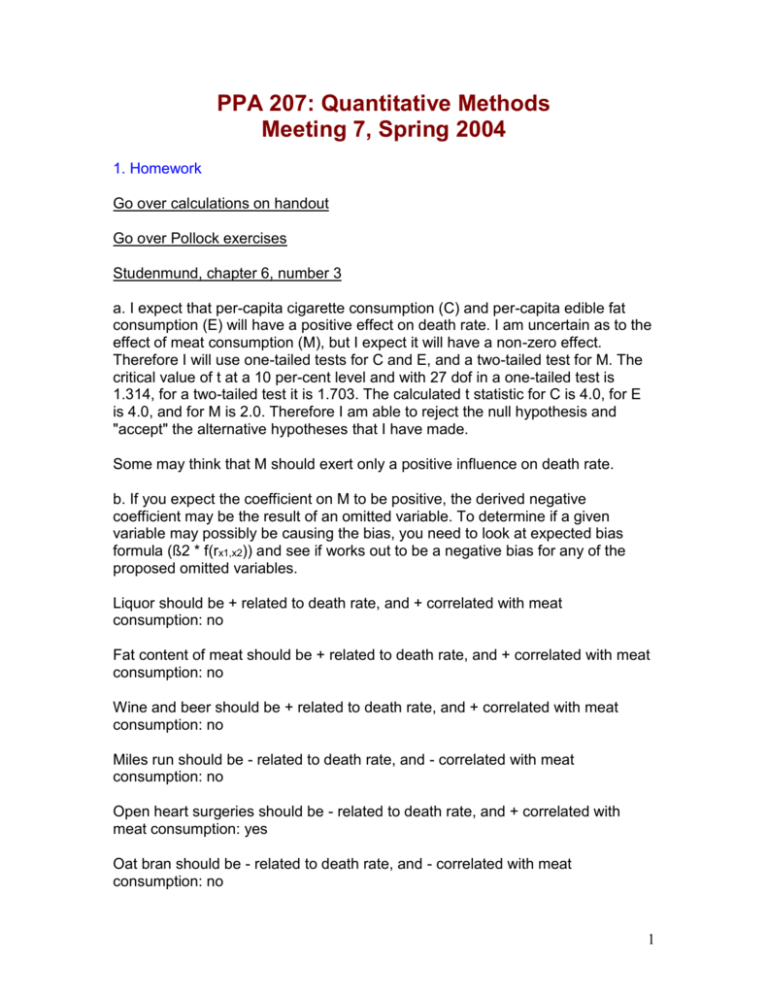
PPA 207: Quantitative Methods Meeting 7, Spring 2004 1. Homework Go over calculations on handout Go over Pollock exercises Studenmund, chapter 6, number 3 a. I expect that per-capita cigarette consumption (C) and per-capita edible fat consumption (E) will have a positive effect on death rate. I am uncertain as to the effect of meat consumption (M), but I expect it will have a non-zero effect. Therefore I will use one-tailed tests for C and E, and a two-tailed test for M. The critical value of t at a 10 per-cent level and with 27 dof in a one-tailed test is 1.314, for a two-tailed test it is 1.703. The calculated t statistic for C is 4.0, for E is 4.0, and for M is 2.0. Therefore I am able to reject the null hypothesis and "accept" the alternative hypotheses that I have made. Some may think that M should exert only a positive influence on death rate. b. If you expect the coefficient on M to be positive, the derived negative coefficient may be the result of an omitted variable. To determine if a given variable may possibly be causing the bias, you need to look at expected bias formula (ß2 * f(rx1,x2)) and see if works out to be a negative bias for any of the proposed omitted variables. Liquor should be + related to death rate, and + correlated with meat consumption: no Fat content of meat should be + related to death rate, and + correlated with meat consumption: no Wine and beer should be + related to death rate, and + correlated with meat consumption: no Miles run should be - related to death rate, and - correlated with meat consumption: no Open heart surgeries should be - related to death rate, and + correlated with meat consumption: yes Oat bran should be - related to death rate, and - correlated with meat consumption: no 1 c. Given what was just shown in b, I would add open heart surgeries. Studenmund, chapter 6, number 13 a and b. I would expect Iowa test score and years of parent's education to have a positive influence on econ test score. I am uncertain about the influence of nonwhite and female on econ test score but would choose negative if forced. Thus X3 and X4, which exhibit positive coefficients are likely to be Iowa score or parent's education. Since X4 exhibits a larger statistical significance (t=12) than X3 (t=2), and I expect Iowa test score to be more likely to exhibit a positive effect on econ score, I say X4 is Iowa test score and X3 is parent's education. Thus X1 and X2 are either minority or female. The t-stat on the X1 coefficient is 1.0, on the X2 coefficient it is 0.25. Since I expect minority to be more likely to exert a negative influence on test score than female, I would name X1 as minority and X2 as female. c. For 19 dofs and a 5 percent confidence level, the critical value of t in a onetailed test is 1.729. In a two-tailed test it is 2.086. The calculated t's on both X1 and X2 is less than both of these critical values so cannot reject the null hypothesis that gender and race has no influence on econ test score. d. I did both, but a two-tailed test is preferred because of the uncertain influence that gender or race has on test scores. 2. Studenmund, Chapter 7, Choosing Functional Form How are explanatory variables related to dependent? Curve instead of straight line Rise to a peak and then fall Fall to a trough and then rise All violate standard “linear in the variables” assumption “Tricks” to deal with Constant term Never suppress its use Figure 7.1 shows problems it creates Never rely on coefficient for constant term to mean anything Elasticity Percentage change in Y for a one-percent change in X Linear functional form What we have been using all along Coefficient represents slope Elasticity equals coefficient times (mean of Y / mean of relevant X) Calculated at mean values 2 Log-log functional form Take log of all variables were possible Coefficient represents elasticity Log explanation e = 2.71828 (natural exponent) The log of X is the power that e must be raised to equal it SPSS will calculate it for you Note that graph of lnY against lnX is linear Though graph of corresponding Y against X takes on nonlinear forms in Figure 7.2 depending on value of β Left log-linear functional form Take log of only dependent variable Coefficient represents how Y changes in percentage terms for a one-unit change in X Elasticity equals coefficient times mean of X Note that graph of lnY against X is linear Though graph of corresponding Y against X takes on nonlinear forms in Figure 7.3 depending on value of β Quadratic functional form Square one of your explanatory variables and add in Change in Y for a one unit change in X (from a given X value) in quadratic form is linear coefficient plus (two times quadratic coefficient times chosen value of X) Example Yhat = 3 + 5X – 0.6X2 Slope of this line at X = 2 5 – 1.2 (2) = 2.6 Slope of this line at X =10 5 – 1.2 (10) = -7 See possibilities in Figure 7.4 Solve for inflection point From previous example 5 – 1.2X = 0 1.2X = 5 X = 5/1.2 = 4.17 Elasticity [Linear coefficient x (meanX / meanY)] + [2 x quadratic coefficient x [meanX / meanY)] See Table 7.1 for summary Never use adjusted R-squared to pick best functional form 3 Theoretically they cannot be compared because of use of different dependent variables Functional form and problems of predicting out of sample See Figure 7.6 Functional form may not apply outside of sampled data Standard dummy explanatory variables Run a regression of Y = yearly salary, X1 = education years, X2 = male dummy Figure 7.7: graph result (plug in actual values) Slope dummy variables Interaction term An additional explanatory variable equal to X dummy variable multiplied by X continuous variable Why create interaction term? Figure 7.8: graph result (plug in actual values) 3. Pollock, Chapter 5, Making Controlled Comparisons Comparison between a Y (dependent) and X variable (explanatory) holding an alternative causal variable (Z) constant Either find that Y and X are spuriously related, or an enhanced relationship after controlling for Z Open GSS1998.sav Recreate Polview3 Polviews 1-3 liberal 4 moderate 5-6 conservative Analyze=>descriptive stats=>crosstabs Dependent Grass into row Independent Polview3 into column Make sure Cells=>columns (%) checked Crosstab matrix is result Now add a layer with Kids as control variable Clustered bar charts Graphs=>bar=>clustered Define=>bars represent=>other=>Grass Change summary=>percentages High = 1, low = 1 Category axis=>Polview3 Define clusters=>Kids 4 Options=>uncheck display groups by missing values Multiple-line charts Better if control variable has lots of categories Open Nes2000.sav Analyze=>descriptive stats=>crosstabs Dependent Gayadopt into row Independent Educ3 into column Make sure Cells=>columns (%) checked Crosstab matrix is result Now add a layer with Gender as control variable Graphs=>line=>multiple Define=>bars represent=>other=>Gayadopt Change summary=>percentages High = 1, low = 1 Category axis=>Educ3 Define clusters=>Gender Options=>uncheck display groups by missing values 4. Homework Due the Start of Meeting Eight (1) Read all of the material under meeting eight in the syllabus; come prepared to discuss. (2) A typed and well developed question from reading assignment for week eight. (3) Answer question 13 in Studenmund, Chapter 7, typed on a separate page of paper. Answer questions 1 and 2 in Pollock, Chapter 5, handwritten on given pages and turn in any requested SPSS output. (4) Provide a one-paragraph typed and double-spaced write up of the theory that is behind the regression paper you plan on writing for final project in this course. Begin with this form: Dependent variable = f (Broad Causal Factor1, Broad Causal Factor2, Broad Causal Factor3, Broad Causal Factor4, etc.) Broad Causal Factor1 = f (actual explanatory variable1, actual explanatory variable2, etc.) Broad Causal Factor2 = f (actual explanatory variable3, actual explanatory variable4, etc.) Etc. 5 (5) Collect all of the data you will use for dependent variable and enter it into SPSS. Run Analyze=>descriptive statistics=> frequencies and descriptives. Turn in computer printout. (6) Prepare a one-page, single-sided, information sheet that you can bring to midterm exam next week for use. Turn this in after exam is over. 6
